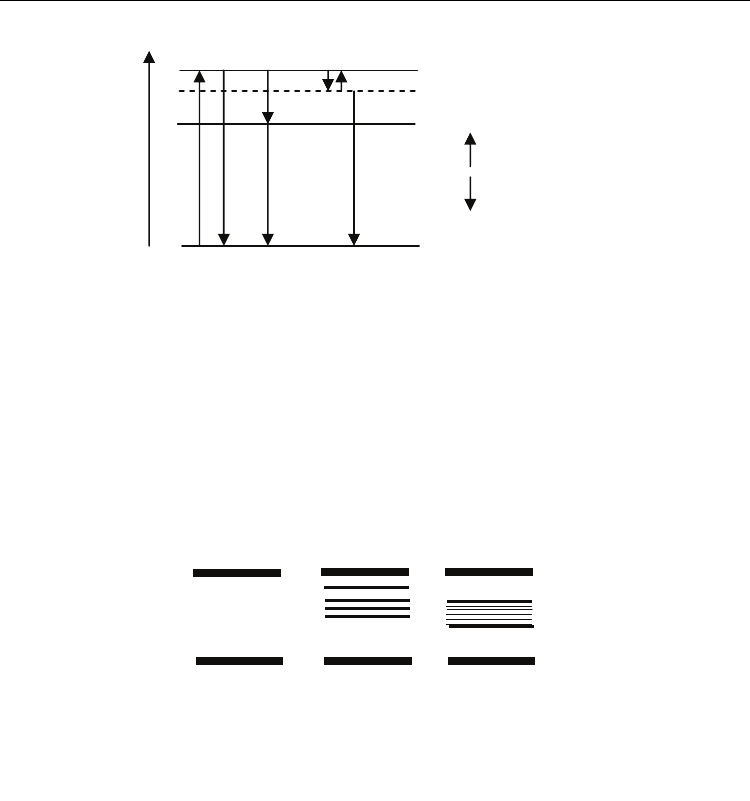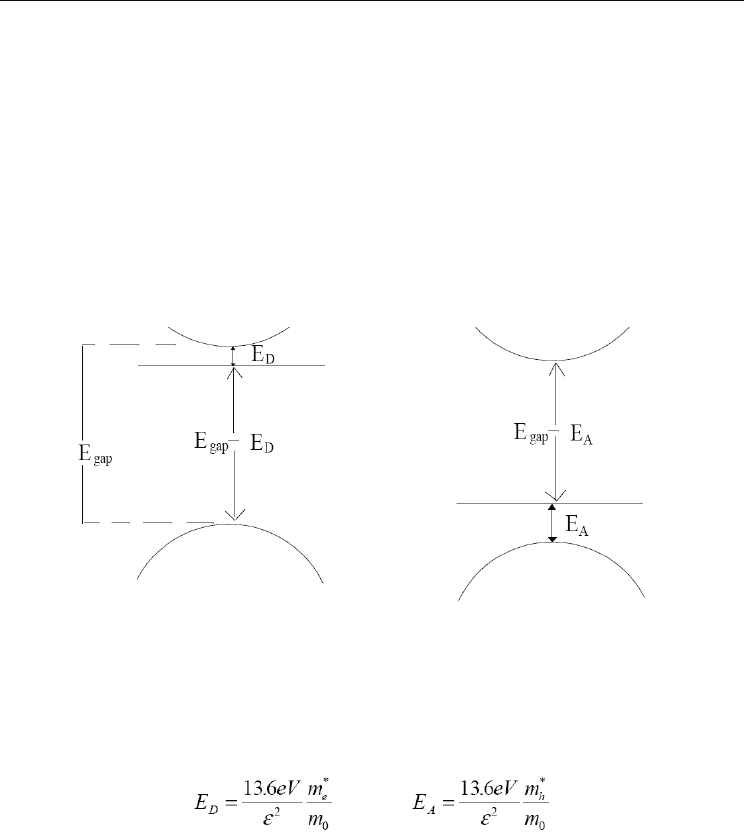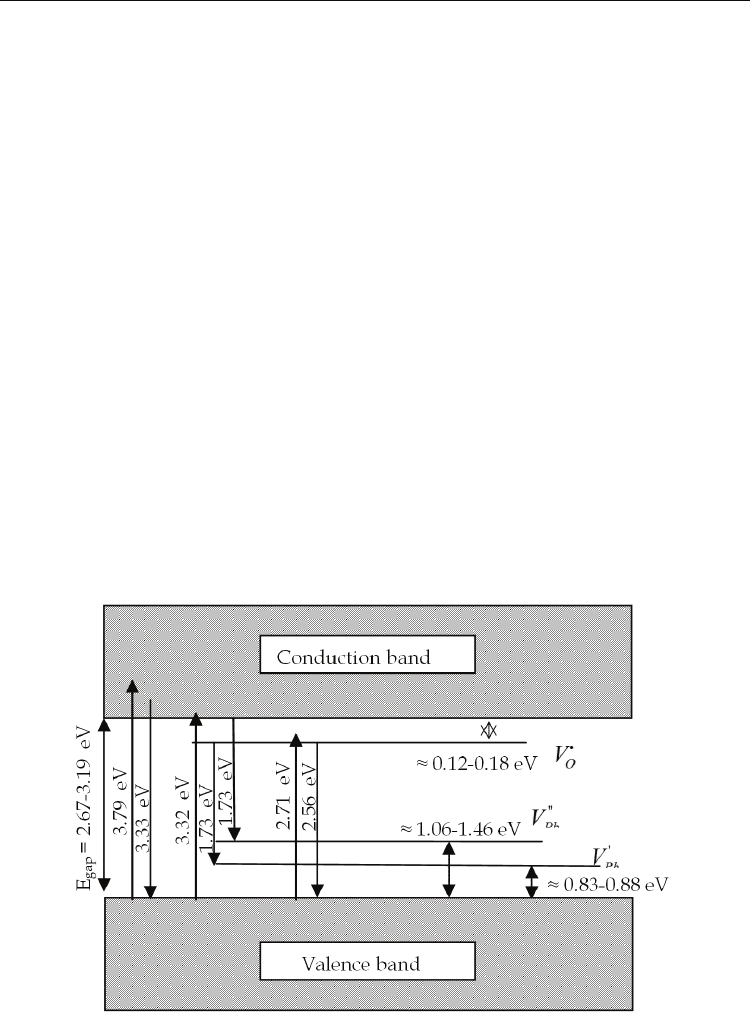Lallart M. (ed.) Ferroelectrics - Physical Effects
Подождите немного. Документ загружается.

27
Photoluminescence in Doped PZT
Ferroelectric Ceramic System
M. D. Durruthy-Rodríguez
1
and J. M. Yáñez-Limón
2
1
Cybernetic, Mathematics and Physics Institute
2
Centro de Investigación y de Estudios Avanzados del Instituto Politécnico Nacional
1
Cuba
2
Mexico
1. Introduction
The photoluminescence (PL) it is a non thermal origin process, in that a chemical compound
absorbs the photons (of the electromagnetic radiation), jumping to an electronic state of
more energy, the inverse process happens and so call recombination (when passing to
inferior energy level) and the materials radiating photons. The period between absorption
and emission occur is in order to 10 nanoseconds. But under special circumstances, this
period can extend in minutes or hours. The transition energy is determined by quantum
mechanics rules. Different imperfection presents in the materials study will alter the
recombination time or frequency.
Simpler PL processes are resonant radiations, in that a photon of a particular longitude
wave is absorbed and an equivalent photon is emitted immediately. This process doesn't
involve any transition in forbidden energy band and it is extremely quick (10 ns). The most
interesting processes happen when the desexcitation energy transition is not direct at the
basic level. The most common effect is the fluorescence that is also typically a quick process,
but in that the original energy it is dissipated so that the slight photons emitted are of the
lower energy that those absorbed. This phenomenon can happen for the isolated atoms,
molecules or atoms and molecules in interaction excitement.
1.1 Atomic, molecular and atoms and molecules in interaction luminescence
The isolated atom excitement (making notice that a very rarefied gas can be considered as a
group of isolated atoms) it drives to a spectrum of lines. The atom only absorb the frequency
of the incident ray that corresponds to the allowed transitions (Figure 1). So all the isolated
atoms can be luminescent.
That happens for the isolated atoms is also valid for the isolated molecules, but the laws are
more complicated due to the vibrations and rotations molecular than they introduce
supplementary energy levels as the sample the following diagram of figure 2.
The pressure of a gas it increases and a new transitions of excitement energy appear by
collision, for the appearance of kinetic energy and metastable states. The return to the basic
state is with a reduction of the yield of the luminescence and an expansion of the spectrum
of the transmission. Then appears spectrum of band. The return to the fundamental state it
doesn't always happen with light emission (transitions without radiation).

Ferroelectrics – Physical Effects
620
Fig. 1. Three possible luminiscence types of an isolated atom:
1) direct transition, this is a resonance phenomenon;
2) indirect transition, distributing the energy in several photons hν
1
and hν
2
,
3) indirect transition by a metastable state (M) following by interatomic collision (not very
probable).
1.2 Crystalline luminescence
The luminescence of the crystalline bodies is due to the transmission centers (the activators).
These centers are:
- physical imperfections in crystalline structure (vacancies, interstitial atoms,
dislocations), this is intrinsic luminiscence.
Fig. 2. Energy levels that appear in a molecule.
- chemical imperfections (impurity atoms) in interstitial or substitution position, this is
extrinsic luminiscence.
The mechanism of crystalline luminiscence it is explained with the help of energy bands
diagram (Figure 3).
Considering that in the perfect crystal any level doesn't exist in forbidden band, the presence
of imperfection in the cystal introduces some levels allowed in the forbidden or in the
allowed bands. These energy levels they can be:
- recombinations levels (h/e -)
- metastable levels: the traps of e- (Pe) or h (Pt)
- fundamental (F) and excited levels (E) of isolated centers
F
E
2
1 2 3
E
1
M
h
ν
h
ν
1
h
ν
2
E
excitation
recombination
()
⎛⎞
⎜⎟
⎛⎞
⎜⎟
⎜⎟
⎜⎟
⎜⎟
⎜⎟
⎜⎟
⎜⎟
⎝⎠
⎜⎟
⎝⎠
electronic
+
electronic
electronic + vibration
+
vibration
rotation

Photoluminescence in Doped PZTFerroelectric Ceramic System
621
The spectra of crystalline luminiscence differ notably of the atomic spectra for two
fundamental aspects. 1): bands are observed and 2) the emitted radiation appears toward
the longitude of big waves, this can made a mistake with the absorbed radiation. These two
aspects are due to the interaction between the emission center and the crystalline lattice.
According to the type of imperfections there are the transitions way and therefore the
energy of the transition.
A first transition consists on an electron that leaves a donor level and go toward the valency
band. The energy of this transition is given for: E=Egap-Ed
Also, can be observed where an electron leaves to the conduction band to pass at aceptor
level. In this case, the energy of the transition is given for: E=Egap-EA
Fig. 3. Types of transitions among bands.
It is known that the energy E
D
and E
A
differ according to the chemical nature of the
impurity. For this reason is allows to use the photoluminiscence experiments to confirm the
presence of a specific type of impurity in a material.
In many cases, the theory of the effective mass is a first valid approach, it predicts the value
of the energy E
D
and E
A
for a given semiconductor.
and
(1)
In general m
*
h
>>m
*
e
, it is explained, why the bond energy of aceptor levels is bigger than
that donors levels.
Broad bands are observed for many optical transitions in the partly filled d-shell of
transition metal ions (d - d transitions), but also for transitions between the 5d shell and the
4f shell of rare-earth ions (d - f transitions) and for emission on s
2
ions (these ions possess a
‘‘lone pair’’ of s electrons), like T
l+
, Pb
2+
, or Sb
3+
. Sharp emission bands are characteristic of
optical transitions between electronic states with chemical bonding character (almost) the
same for ground and excited state, and for the same reason also of optical transitions
between electronic states that hardly participate in the chemical bonding (e.g., f - f
transitions on rare-earth ions).
Transition: donor-valence
band
Transition: conduction band-
aceptor

Ferroelectrics – Physical Effects
622
In the case of optical processes involving electronic states which participate in the chemical
bonding, the nature of the bonding (covalent, ionic) and the symmetry of the site at which
the emitting ion is incorporated play a very important role. This is generally described by
the ligand field theory, which we do not treat here.
The emission generated reflects how the optical properties of the ion depend on its chemical
environment. This luminescent material can be applied as green phosphor in very high-
quality fluorescent lamps and also in plasma display (Ronda, 2008).
2. Luminescence in PZT
The width of luminescent band usually observed at room temperatures in crystals of
perovskite type it is associated with the presence of imperfections or defects (Haertling,
1999; Anicete-Santosaet al., 2007), be already oxygen or lead vacancies. But other author
explain apparition of PL to order-disorder presence in the structure (Chen et al., 1989;
Suárez-Gómez et al., 2009; Shannigrahi, 2007) distortion of oxygen octahedral
fundamentally.
Undoped PZT ceramics are seldom used. They are usually substituted in the A or B-sites of the
perovskite structure ABO
3
in order to improve dielectric, piezoelectric and mechanical
properties. For example La
3+
and Nb
5+
are used satisfactorily (Durruthy et al., 1999, 2002;
Bharadwaja et al., 2002). The excess of positive charge in (La/Nb) doped PZT is compensated
by lead vacancies and the typical Kröger-Vink notation to describe the electroneutrality, have
been reported in many papers previously (Eyraud et al, 2006; Jaffe et al., 1954).
The defects caused by the small dopant concentrations in A or B places of the structure could
generate a combination of blue, green and red emission of light which is of great importance
for optical devices applied in optoelectronics includes flat-screen, full-colour displays and
compact laser devices operating in the blue region (Nakajima et al., 2004; Yang et al., 2008).
Recently M.S. Silva et. al., 2005, reported a theoretical and experimental result, and presents
an alternative method to process PL in PZT and aim to explain why this phenomenon
depends on the crystalline structure of the material. The wide bands at 2.1 and 2.67 eV
respectively in PL emission in perovskite ceramics are associated to the oxygen vacancies
provoked during the sintering process (Lines & Glass, 2001) or related to ensure
electroneutrality process.
What happens with luminescence effect with A, B or A+B doped PZT?
We will try to respond this question with several examples.
All samples that show were prepared by a conventional processing method using mixed
oxide powders. The photoluminescence (PL) spectra were obtained using a Jobin Yvon
Horiba Fluoromax-3 spectrometer using the excitation band at 373 nm. The absorption
spectra were acquired with an UV-vis Ocean Optics Spectrometer QE650000 using diffuse
reflectance measurements the data was processed by using the Kubelka-Munk function:
∞
∞
∞
−
2
1
2R
´
´
´
(R)α
F(R ) = =
S
(2)
sample
standard
´
R( )
R=
R( )
∞
∞
∞
(3)

Photoluminescence in Doped PZTFerroelectric Ceramic System
623
R
∞
= (I/I
0
) is diffuse reflectance at one wavelength from an opaque sample with infinite
thickness (> 2 μm), 0< R
∞
<1, α is the absorbance in cm
-1
and S is the scattering factor which
is assumed to be independent of the wavelength for grain sizes greater than the wavelength
of the light (Wendlandt & Hecht, 1966; Kottim, 1969).
Crystalline structure (Figure 4), like we will see later, influences in the shift energy of PL in
the samples. For this reason it is advisable to carry out this study previously to PL analysis.
All samples firth were identify by X-ray diffraction (XRD). The XRD patterns of the
polycrystalline samples show the tetragonal (Zr/Ti = 20/80, 40/60) and rhombohedral
(Zr/Ti = 60/40, 80/20) PZT phases, and both phase together for Zr/Ti = 53/47. This is a
classical behavior for this material and has been reported by some authors (Jaffe et al., 1971;
Noheda, 2000, 2001).
Fig. 4. Phases diagram of PZT, appear the existence range of each phase (tetragonal and
rhombohedral), the morfotrópica phase boundary (MPB) according to Jaffe et al. (1971).
In our samples doped the compensation of charge provokes in all cases oxygen vacancies
that should increase with the dopant concentration or saturates in a composition that
denotes a limit of solubility. However, oxygen vacancies are easily induced during the
sintering process because the PbO has low volatile temperature of about 880ºC. This
phenomenon takes place in all samples and also promotes lead and oxygen vacancies, which
are quenched defects at low temperatures. Lead vacancies can only become mobile at high
temperatures with high activation energy greater than oxygen mechanism values.
According to Eyraud et. al. (2006) singly and doubly ionized lead and oxygen vacancies
coexist in the PZT ceramic, then they may constitute donor and acceptor sites which are able
to exchange electrons according to the following reactions:

Ferroelectrics – Physical Effects
624
'
'''
Pb Pb
Pb Pb
OO
OO
VVe
VVe
VVe
VVe
→+
→+
→+
→+
i
iii
(4)
in our case at least three types of defects coexist
'"
,
Pb Pb O
VVandV
i
, whose contribution to PL
depends on the levels in the band gap.
The results of first-principle calculation reported by Ghasemifard et al., (2009) show that the
PZT polycrystalline has a direct band gap between the X and Γ points of 3.03 eV (Baedi et
al., 2008), then by assuming a direct band gap we can calculate the values of the energy gap
(Eg) for all the samples. In general calculating the absorption coefficients of the synthesized
powder in the strong absorption region needs both, the transmission and reflection spectra.
In our case, we obtained the absorption spectra by diffuse reflectance measurements, and by
using the Kubelka-Munk equation for all samples the band gap energy Eg was determined.
2.1 Substitution in A site
The substitution for La
3+
in the A site of perovskite structure it’s traditional. It is one of the
classic sustituyentes in this system.
The emission spectra (PL) at 273, 325, 373, 413 and 457 nm were characterized to present
different bands for PLZT 1-x/x/y (Figure 5), prevailing blue-violet band presence (2.4-2.75
eV), it’s appears at bigger intensity for 413 nm. This evidences that PL effect has the same
origin in all cases.
As it has been expressed previously, the energy of the spectra of PL demonstrates the
presence of levels in the forbidden band. The calculations of first principles (Longo et al.,
2005) have been demonstrated that disorder in perovskite structure and the defects in the
same one, they cause states in the forbidden band. On the other hand the experimental
evidence of the presence of defects exists (oxygen vacancies) (Mansimenko et al., 1998)
starting from mensurations of resonance electronic paramagnética (RPE) in the system
PLZT.
If we consider to our materials as semiconductors of big gap, the presence of states in the
forbidden band, what causes a contraction of the gap, is the causing of a well-known
Burstein-Moss shift of emission spectrum (Yu & Cardona, 1996). It can associate to presence
of picks around 2.65 eV to the presence of bands inside of forbiden band in the material,
being more intensity when it’s excited with λ= 413 nm.
Analyzing the results associating them with the colors corresponding of the wave
longitudes, we see that emissions exist (although of different intensity) in almost the whole
visible spectrum, from the red one until the ultra violet, but the bands of very high intensity
correspond to the bands of the blue-violet and ultraviolet.
The motive that causes this effect are similar when you doped these materials in B site, this
will be explained in the next section.
2.2 Substitution in B site
In perovskita structure (ABO
3
) N
5+
substitute B site, occupied by Zr
4+
and Ti
4+
ion. The high
volatility of lead oxide at elevated temperatures during the powder calcinations and the

Photoluminescence in Doped PZTFerroelectric Ceramic System
625
Fig. 5. PL spectra at room temperature, fixing the excitation band at 273, 325, 373, 413 and
457 nm in PLZT ferroelectric ceramics. Appear result for two point of PZT phase diagram
doped at different La
3+
concentration.
sintering stages in the PZT system is known, which provides both fully-ionized cationic lead
"
Pb
V
vacancies and anionic oxygen vacancies
O
V
ii
. On the other hand, following Eyraud’s
model (Sivasubramanian et al., 2007; Chang et al., 2001) the valence of the Niobium is
assumed as donor doping in the PZT has a strong influence in the ionization state of
extrinsic lead and oxygen vacancies.
Figure 6 shows the PL spectra of PZTN samples for compositions 80/20, 60/40, 53/47,
40/60 and 20/80 which have diverse dopant concentrations. The emission bands (PL
response) when fixing the excitation bands (EB) at 373, 457 and 325 nm were observed in
three regions: one is at around 1.72 eV (lowest energy region); the second is at around 2.56 –
2.61 eV which shows a higher intensity, and the third is at around 3.35 – 3.45 eV (highest
energy region) respectively. The band at 2.56 eV is the most intense and narrow, and the
band at 3.35 eV shows greater broadening. The band at 1.72 eV did not show any notable
shift in the maximum position peaks for different compositions or dopant concentrations.
Nevertheless, the bands at 2.56 and 3.35 eV show a shift in the maximum peak position
which depending if the phase is rhombohedral or tetragonal will shift to 2.61 and 3.45 eV,
respectively.

Ferroelectrics – Physical Effects
626
Fig. 6. Room temperature PL for PZTN note the dispersion for non doped materials. For
PLZT 1-x/x/1.0 practically all the curves coincide for the same energy 1.72 and 3.36 for λ=
373 and 325 respectively.
Note that in the PZT polycrystalline samples without Nb, the three well resolved emission
bands were also shown, in contrast with other reports (Longo et al., 2008; Chang et al., 2001)
where the emission for polycrystalline PZT is very low and broad or absent. For these
materials (PZTN) the emission is bigger in 1 or 2 order than PLZT. The PLE spectra for
samples doped and without doped they present same character, appearing the same line, for
what they have the same origin in both cases (Figure 7).
The E
g
(in PZTN) values for tetragonal samples 20/80 and 40/60 are between 2.80 to 2.98
eV, the composition 53/47 are near the morphotropic phase boundary which shows a higher
variation in E
g,
values as a function of the dopant concentration from 2.70 to 3.19 eV. For this
composition and rhombohedral phases 60/40 and 80/20 the behavior of E
g
values as a
function of Nb concentration shows a minimum at 0.8% with values of approximately 2.67
to 2.70 eV. In our case, experimentally it is observed a transition (E
PL
) at 2.56 eV for samples
PZTN 80/20/0.0.
Sintering stages in the PZT system is known, which provides both fully-ionized cationic
lead
"
Pb
V vacancies and anionic oxygen vacancies
O
V
ii
. On the other hand, following
Eyraud’s model (Sivasubramanian et al., 2007; Chang et al., 2001) the valence of the
Niobium is assumed as donor doping in the PZT has a strong influence in the ionization
state of extrinsic lead and oxygen vacancies.

Photoluminescence in Doped PZTFerroelectric Ceramic System
627
Fig. 7. Room temperature excitation spectra PLE for PZTN for an emission at 475 and 715
nm respectively.
The E
D
values reported in Table 2 were calculated using E
g
and E
PL
obtained by excitation at
EB=457 nm. Even the origins of these luminescence bands are not clearly understood. Figure
8 shows a schematic diagram to represent the recombination process for the three emission
bands. The PL at a high energy region of approximately 3.35-3.45 eV, that overcomes the E
g,
which is obtained when the excitation is at 3.81 eV.
% Nb
E
g
a
p
(Zr/Ti)
20/80 40/60 53/47 60/40 80/20
Eg E
D
Eg E
D
Eg E
D
Eg E
D
Eg E
D
0.0 2.80 0.19 2.92 0.31 3.19 0.63 3.04 0.48 3.09 0.53
0.2 2.84 0.23 2.86 0.25 2.93 0.37 3.04 0.48 3.04 0.48
0.4 2.84 0.23 2.84 0.23 2.90 0.34 2.92 0.36 2.96 0.40
0.6 2.82 0.21 2.86 0.25 2.85 0.29 2.85 0.29 2.85 0.29
0.8 2.87 0.26 2.80 0.19 2.70 0.14 2.67 0.11 2.67 0.11
1.0 2.90 0.29 2.98 0.37 3.00 0.44 2.95 0.39 2.94 0.38
Table 1. Band gap energy (Eg) for PZTN, determined using the diffuse reflectance principle
(Kubelka-Munk expression). Error Eg= ± 0.003 eV. ED values obtained with the Eg and
more intense emission band at around 2.56 eV.

Ferroelectrics – Physical Effects
628
This corresponds to transitions between higher energy states in the conduction band to the
valence band (hot luminescence), and the emission intensity shows a strong dependence on
the Nb concentration.
The PL at 1.73 eV, the lowest energy region which is obtained with excitation energy of 3.32
eV, it could be follows a recombination mechanism:
1. from the localized states due to oxygen vacancies below the conduction band (
O
V
i
) to
the localized states above the valence band due to lead vacancies (
'
Pb
V
) and/or
2. by recombination from band conduction to the localized states above the valence band
due to lead vacancies (
''
Pb
V
).
The intensity emission of this band also shows a strong dependence on Nb concentration,
and is present in all compositions indicating common defect types related to a deep level
inside the band gap. In general, the incorporation of Nb
5+
increases the PL intensity in this
region due to the compensation of charge and induced defects (
'
Pb
V
and
''
Pb
V
), as it was
already seen previously.
In this case the simultaneous disorder of lead and oxygen vacancies should be created
during the sintering process. The PL at 2.56 eV, which shows the highest intensity in all
PZTN compositions and is associated to a transition between a shallow defect in the band
gap and the valence band, see Figure 8. These levels are associated to oxygen vacancies,
with simple or double ionization which is in accordance with the classification of Longo et
al., (2008), vacancies bonded to clusters of TiO
5
in disordered regions. In principle, the
incorporation of Nb
5+
in PZT samples would be producing more lead vacancies than oxygen
vacancies. However, the higher intensities observed for peaks at 2.56 eV rather than peaks at
around 1.73 eV is an indication that the oxygen vacancy concentration is higher than lead
vacancies.
Fig. 8. Schematic diagram of recombination process associated with the emission bands in
PZTN ceramics, for excitation energy 3.79, 3.31 and 2.71 eV.
